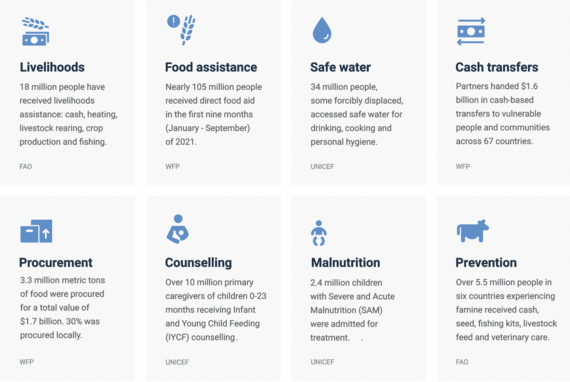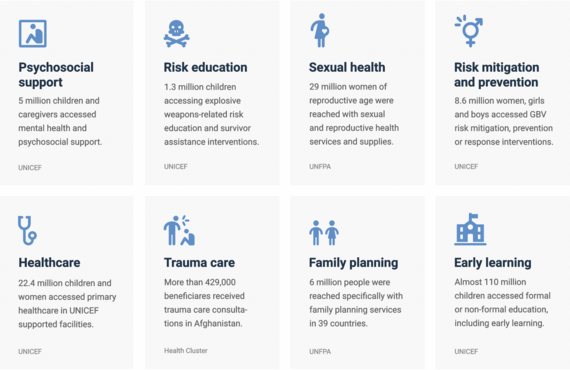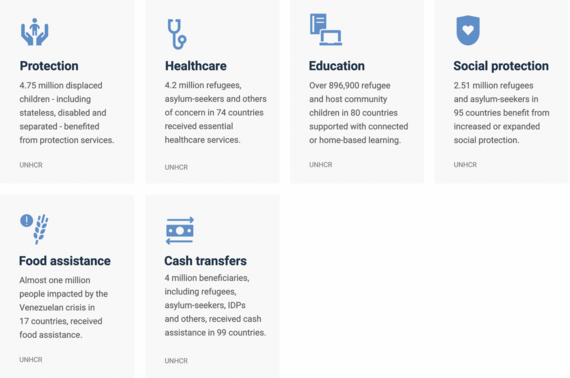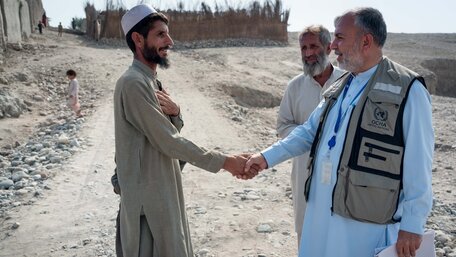Port-au-Prince, Haiti
An IOM officer checks in with a displaced person at the Delmas 103 school in Port-Au-Prince, a temporary shelter for over 200 disabled residents who had been targeted by gang violence. OCHA/Matteo Minasi
Humanitarians responded within an ever-changing landscape in 2021, urgently delivering assistance to people caught up in crises. The COVID-19 pandemic and its effects compounded multiple challenges already facing humanitarian workers including violent conflict, rising hunger and the devastating impacts of climate change. Local partners stepped up to help access areas that could not be reached by international responders and deliver critical aid.
In 2021, the United Nations and partner organizations aimed to assist 174 million people, through 38 country plans and 7 regional plans. Of the 153 million people targeted by plans at country level, 107 million were reached - 70 per cent of the total targeted. The people reached figure includes all targeted people who benefited from at least one form of aid in the year.
People reached by HRPs (2021)
Life-saving food assistance has been delivered to multiple crisis situations in 2021. In northern Mozambique, humanitarian organizations significantly scaled up their response, enabling partners to provide life-saving and life-sustaining assistance and protection to 1.23 million people — more than double the number of people reached in 2020. In South Sudan, humanitarian action brought six counties back from the brink of famine through a targeted, multisectoral scale-up in the most food insecure areas. Over 500,000 severely food insecure people facing catastrophic levels of acute food insecurity (IPC Phase 5) received life-saving assistance, and 100,000 families received livelihoods assistance. As of September 2021, food assistance has been delivered to 7.5 million people in Afghanistan, and as of August 2021 almost 6 million people were reached with regular food baskets in Syria — a country that has seen a steep rise in the cost of food baskets.
As the impacts of conflict on civilians continue to grow, humanitarians operated in risky environments to help those in need. Despite the impact of protracted occupation in oPt, assistance continued to be delivered in 2021. Humanitarians responded to the escalation of hostilities and unrest in Gaza and the West Bank while also meeting the additional needs resulting from the pandemic. In Libya, Mine Action partners cleared almost 2.3 million m2 of explosive hazards.
The provision of basic services for those most in need has continued in 2021. In Iraq, 1.2 million returnees and IDPs received assistance. This includes over half a million people who accessed basic health care; water, sanitation and hygiene (WASH) services; and special protection services. In Venezuela, 1.8 million people received WASH assistance, and 537,000 women, men, girls and boys were assisted with protection services, including access to legal documentation and information.
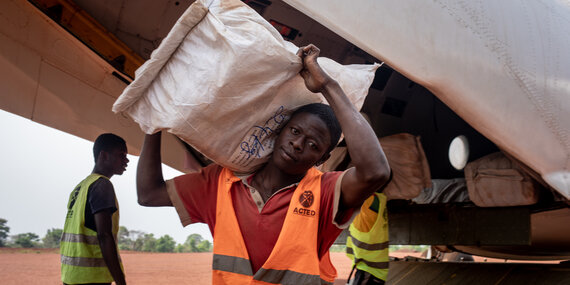
Achievements by sector
Bangassou, CAR
A local worker unloads a cargo plane carrying humanitarian aid in Bangassou,
Overcoming disruption to health services
Global health services have been disrupted due to the COVID-19 pandemic, severely impacting the most vulnerable. Humanitarian response has included the provision of personal protective supplies in 29 countries, life-saving child immunization campaigns and the supply of critical hygiene items and services.
Averting alarming levels of hunger and extreme poverty
COVID-19 has devastated livelihoods around the globe and extreme poverty is rising. Drought, floods and other climate crises have threatened the livelihoods of those living in rural areas in addition to ongoing conflict and political instability. The number of acutely food insecure people has increased dramatically and the risk of famine is now a reality. Humanitarians have responded with urgent actions including cash-based transfers and direct food assistance, support to the self-employed, live-stock feed and help with crop production.
Prioritizing the Most Vulnerable People
The COVID-19 pandemic and its effects have taken a heavy toll on the most vulnerable in communities, who were already experiencing disproportionate challenges in accessing services including health care and education. Humanitarians have responded with actions including the provision of facilities for women and children to access reproductive health services, supporting persons with disabilities to participate in communities and assistance to survivors.
Basic Services to Support Refugees
The number of refugees remains at a record high. As crises become increasingly complex and protracted, fewer can return home and are living-in crowded conditions with limited access to water, sanitation and health facilities. The humanitarian system has provided key services to support refugees, almost half of which are women and girls. This includes provision of safe drinking water, cash assistance, mental health services and vital health care.
Mainstreaming Protection and Gender-Based Violence
Over 70 per cent of women and girls living in some conflict contexts have experienced GBV. The pandemic’s socioeconomic impacts have only intensified this risk. Greater access to social protection and affordable, quality and accessible health-care services is urgently needed. Humanitarian actors have provided protection services including legal aid, GBV services and psychological support to vulnerable groups including women and girls, young people refugees and asylum seekers.
Ensuring Timely and Efficient Humanitarian Operations
From moving goods and equipment to relocating disaster-affected people, humanitarian response relies on efficient transport and communications systems to reach those in crises and provide the help they need. Coordination and information management is key to supporting operational decision-making and improving the predictability, timeliness and efficiency of the humanitarian emergency response.
Providing Multi-Sectoral Responses to Regional Situations
At regional level, humanitarian partners continued joint and coordinated efforts to address the needs of and risks faced by refugees and migrants, as well as other persons of concern, and host community members in 39 countries. Inter-agency partners focused on ensuring protection and promoting solutions through multi-sectoral response activities supporting the objectives stated in the 2016 New York Declaration for Refugees and Migrants and ensuring appropriate linkages with the Global Compact on Refugees (GCR) and Global Compact on Migration (GCM).



